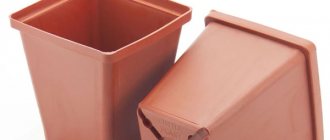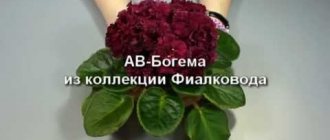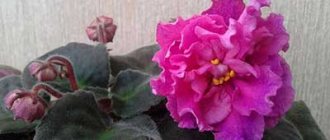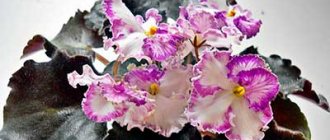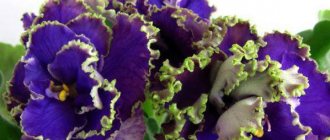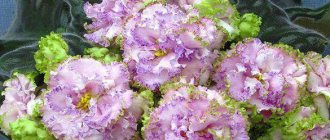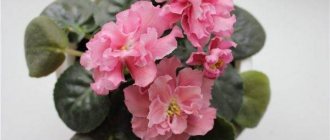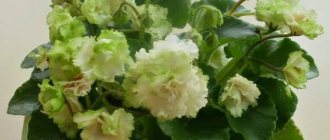Among the variety of varieties of violets presented, one species attracts special attention from flower growers and collectors.
This is due to the peculiarity of the color of the petals, in the center of which there is a pigmented stripe that differs from the main color.
Such stripes are less common on leaves. This species is on the list of the rarest and most expensive . His name is Chimera.
What flower is this called?
The Chimera owes its name to the ancient Greek mythical creature of the same name.
He was described as a goat with the head of a lion and the tail of a dragon, capable of spitting fire.
Centuries later, chimeras began to be called fictional animals, as well as fiction and fantasies, the existence of which is very difficult to believe.
The uniqueness of Chimera violets lies in the fact that they contain intertwined cells of different varieties. In this case, the cells of the varieties that make up the chimeras do not mix with each other and form layers. The bottom layer sets the color of the petal, the top layer - the stripe that lasts from its base to the tip.
There are the most diverse and bizarre combinations.
It turns out that one violet, like the ancient Chimera, consists of two or more components that belong to other violets . It's really hard to believe, but it's a fact.
The second method of obtaining seedlings
In this case, first, all the buds and flowers on the queen cell are cut off, after which the sections are sprinkled with charcoal. In this case, it is very important not to touch the 2 small leaves that are located under the buds. After two to three weeks have passed and the leaves have grown, the peduncle will thicken and its diameter will double. New rosettes of the leaf axils will appear, after which it is necessary to cut off the leaves of the mother plant, which will interfere with bending the peduncle to the soil and sprinkle with soil so that it takes root. To increase the flow of nutrients and accelerate the growth of this stem, it is necessary to pincer the top of the queen cell. It is best to keep a “chimeric” queen cell in a small greenhouse with good lighting and high humidity. With this content, roots form on the peduncle after 2-3 months have passed. The stem of the plant must be tilted slowly, gradually, and after it bends towards the ground, cover it with substrate on top.
From a rooted peduncle, 1 or 2 new rosettes can form, which will be new, “chimera” violet rosettes. After some time, they can serve as new queen cells for propagating Saintpaulias. This method is quite painstaking and its use will require patience and vigilant attention to the plants. But any florist is a special person: positive results are the highest reward for them.
- Posted by fenix
Rate this article:
- 5
- 4
- 3
- 2
- 1
(0 votes, average: 0 out of 5)
Share with your friends!
History of the species
During the process of violet domestication, an incomplete mutation occurred in the flower cells. Most of the cells received the characteristics of the mother plant, and a smaller part received the characteristics of another species. Since then, chimera violets have appeared in the process of reproduction.
Expert opinion
Pavlova Ekaterina Mikhailovna – agronomist, landscape designer
Participant of scientific conferences
Chimeric mutations still appear spontaneously. For example, the owner of a violet with pink petals, after rooting the cutting, may have a plant with purple stripes in the middle of the petals. Despite the efforts of scientists, it is impossible to obtain such mutations artificially in laboratory conditions. They arise by themselves.
The fact is that tissues of different cellular composition fit tightly to each other, but do not mix.
All that remains is to consolidate the emerging characteristics in a stable combination through selection . However, maintaining a stable color is not an easy and very painstaking task, since the mutation does not appear in every daughter plant.
LiveInternetLiveInternet
Quote from the message VENERIN_BASHMACHOK
Read in full In your quotation book or community!
Saintpaulia chimeras.
Chimera (ancient Greek Χίμαιρα, “goat”) - in Greek mythology, a monster with the head and neck of a lion, the body of a goat, and a snake-shaped tail; the offspring of Typhon and Echidna. In a figurative sense - an unfounded, unrealizable idea. Chimeras are also called “...animals or plants, different cells of which contain genetically heterogeneous material
, unlike ordinary organisms, in which each cell contains the same set of genes. Chimeras are a special case of mosaicism. Occurs as a result of mutations, recombinations, and disruption of cell division. Chimera violets are the real treasures of our collections. Recently it has become fashionable to keep collections of chimeras. More and more violet lovers dream of becoming owners of exclusive Saintpaulias. You can recognize a chimera by the presence of a clear stripe of a different color on each petal. These are quite rare, expensive plants. The reason for this is limited reproduction capabilities. They have one “capricious” feature! Never buy leaves from this plant - you will never have the variety you see... This is the chimera of the flower. The variety is repeated only if the baby is transplanted from the same mother plant. And you can also get a plant of the same variety by growing a new plant from a peduncle! And this is not an easy task!
Saintpaulia chimera Kilauea (Eyerdom selection)
Chimera violets are an interesting and unique group of violets. They are not specially bred; they are obtained through random mutation. On the original plant, the color with a stripe in the middle of the petal is permanently preserved, but when propagated by leaf cuttings, it is not. You can repeat a plant with a given color only by rooting peduncles or stepsons, and not always with one hundred percent success.
Saintpaulia chimera Neptune's Jewels
So the original cultivar almost always remains the only one. Currently, one of the leading collectors of chimera violets in Russia is Vladimir Kalgin, the founder of the House of Violets.
Saintpaulia chimera Neptune's Jewels
It is not so easy to obtain a separate variety of violets; breeders have been breeding them for many years, sometimes it takes 4 to 5 years, planting them in hundreds of seedlings, and then selecting the ones they like the most. Chimera violets are bred precisely by such a random change in previously obtained varieties. Chimeras also learned to propagate not immediately, but violets are propagated by cutting off the upper part of the plant.
Another chimera Neptune's Jewels
This must be done in the following way: you need to free part of the stem at the cut site, tearing off a couple of leaves, but in such a way that there are enough of them both on our plant and on the cut top. In order for our top to take root, it must be planted in a pot with a light substrate, and then placed in a plastic greenhouse. After a month, the violet will have roots and can be removed from the greenhouse. The violet will have stepsons at the cut site; when they grow 4 leaves, they can be safely separated from the mother plant. For rooting, they are also placed in greenhouses.
Another way to propagate chimera violets is by rooting flower stalks.
Bold Party Girl (LLG/P. Sorano)(chimera?)
When rooting each plant, you will not be sure that you have received exactly a chimera; in order to be convinced of this, you need to wait for them to bloom, only after that you can say that it is a chimera. The violet is a very unique flower, and can always surprise its owner by the fact that it can bloom completely according to to another, not like her mother.
Chimera Forest King, sport from Buckeye Irish Lace (in the AVSA (American Association) database this chimera is already registered under a different name: Ko's Chortle (10125) 09/09/2009 (S. Ko) Semidouble chimera fuchsia ruffled pansy/white stripe, green edge. Variegated medium green and cream, wavy. StandardSport of Buckeye Irish Lace. That is, the Forest King is our popular name for it, and the correct name is Ko's Chortle).
Another chimera Forest King, sport from Buckeye Irish Lace
Lyon's Fortune Teller (LLG/Sorano)
This must be done in the following way: you need to free part of the stem at the cut site, tearing off a couple of leaves, but in such a way that there are enough of them both on our plant and on the cut top. In order for our top to take root, it must be planted in a pot with a light substrate, and then placed in a plastic greenhouse. After a month, the violet will have roots and can be removed from the greenhouse.
The violet has stepsons at the cutting site; when they grow 4 leaves, they can be safely separated from the mother plant. For rooting, they are also placed in greenhouses. Another method of propagating chimera violets is the rooting of flower stalks. The upper part of the flower stalks has two small leaves called bracts. The flowers must be removed, and the peduncle cut off about 2 cm below these leaves, and then plant them in a pot and place them in a greenhouse. If the bracts were large, then one plant will appear on each of them. When rooting each plant, you will not be sure that you have received exactly a chimera; in order to be convinced of this, you need to wait for them to bloom, only after that you can say that it is a chimera. The violet is a very unique flower, and can always surprise its owner by the fact that it can bloom completely according to to another, not like her mother.
When propagating an ordinary violet by leaf, one plant can produce tens or hundreds of new plants per year. Chimeras do not reproduce by leaves. In order to get new plants from the chimera that repeat the mother’s color, the top of the violet is cut off and rooted. Then, from the remaining lower part of the Saintpaulia, “stepchildren” are grown. From one chimera plant per year you can get from three to 15 stepsons, depending on the age of the plant that was taken for propagation. Unfortunately, not all 100% of the stepsons of the chimera violet will repeat the color when flowering. Comparing the difference in the number of new plants obtained when propagating an ordinary violet and a chimera violet, it becomes clear why they are so rarely found in the collections of Saintpaulia lovers and why they are so expensive.
Chimera Neptune's Jewels again
Another way to propagate chimera violets at home is by propagation by peduncles. Peduncles need to be removed from the plant, all flowers and unopened buds removed from them, planted in a substrate and placed in a greenhouse. This method of propagating chimera violets is even more time-consuming and complex than the first. Basically, this method of propagating Saintpaulia chimeras is used when one chimeric peduncle suddenly blooms on a regular violet variety and it is necessary to preserve and secure the new color in order to develop a new variety of Saintpaulia chimeras.
Granger's Heart's Desire (J. Eyedom)
Be attentive to your violets: occasionally nature presents surprises to Saintpaulia collectors: as a result of a spontaneous mutation, a chimera suddenly blooms among ordinary varieties of violets! The collector, the owner of a real treasure, so far the only such chimera in the world, must preserve, secure, and propagate the new variety.
RS-Romance
Let's take a closer look at the methods of propagating Saintpaulia chimera .
Most Saintpaulia Chimera collectors propagate their Chimeras by “cutting off the head” and raising chimera offspring. This method is propagated only by sufficiently mature chimera violets, which already have many rows of leaves. Because, firstly: the head of Saintpaulia chimera must be cut off with two or three rows of leaves, so as not to damage the growth point of the chimera, thereby destroying it. In addition, the head of a chimera violet with a sufficient number of leaves takes root very quickly, begins to grow and soon blooms.
Secondly, the more rows of leaves remain on the stump of Saintpaulia chimera, the more chimera stepsons it will produce. Sometimes it happens that during a careless operation of removing the top of a chimera violet, all or almost all of the leaves on the lower part of the Saintpaulia, the so-called, are broken off. "hemp". It's not scary. Even if there is not a single leaf left on the Saintpaulia chimera stump, the stepsons will still grow, and even in large numbers. The photo shows how dormant buds awaken from the axils of the leaves of the chimera violet, from which stepchildren will grow:
When the stepsons of Saintpaulia chimera grow enough so that they can be separated without damaging the growth point of the stepson itself, carefully cut them from the stump with a sharp scalpel
. As a rule, stepchildren do not originate and develop simultaneously, therefore, we remove them gradually as they grow
We root the separated stepsons of Saintpaulia chimeras in a cup with a slightly moistened substrate, always in a greenhouse (you can cover each of the cups with Saintpaulia chimeras with transparent bags.
The substrate for rooting the stepson of Saintpaulia chimera should be light, breathable, preferably based on high-moor peat. You can also use sphagnum moss to root Saintpaulia chimera.
Reproduction of Saintpaulia chimeras by peduncles
One can understand Saintpaulia collectors who feel sorry or simply afraid to “cut off the head” of the chimera violet. In this case, you can use a method that is completely painless for violets - propagate the chimera with peduncles. The percentage of repeatability of the colors of the chimera violet in children grown from Saintpaulia peduncles is quite high. Also, this propagation method is simply irreplaceable if a single peduncle of a chimeric color has bloomed on an ordinary violet, not a chimera. By rooting a chimera peduncle, there is a chance to get a new variety of Saintpaulia chimera.
There is also an alternative way of propagating Saintpaulia chimeras by flower stalks. Peduncles are not removed from the plant; faded flowers are simply removed by cutting them ABOVE the stipules of the chimera peduncle. Next, using a sharp object, for example, a syringe, having previously dipped it in a special paste containing cytokinin, carefully apply a small scratch in the area of the axils of the small leaves of the chimera violet peduncle, thereby provoking the rapid appearance of stepsons at the site of the scratch. The percentage of repeatability of the chimera with this method of reproduction is also high. The most complex, expensive, and labor-intensive method of propagating Saintpaulia chimeras is in vitro reproduction. The advantage of this method is that the planting material of chimeras, after stage-by-stage sterilization, comes out very clean and healthy. Plants propagated in vitro grow noticeably faster than their peers propagated traditionally.
In the photo there is a peduncle of a chimera violet in a test tube:
The most valuable diamonds in our collections are leaf chimeras. They are more expensive and are much less common in collections, and there are very few varieties of leaf chimeras.
The photo shows the leaf chimera Harmony's Little Stinker(Harmony):
Another leaf chimera
They are not propagated by flower stalks. Leaf chimeras can be propagated only by cutting off the top and growing stepchildren. Many leaf chimeras contain so little chlorophyll that they die during reproduction. Knowing this, Saintpaulia lovers who have a leaf chimera in their collection often do not dare to propagate this miracle of nature. Some leaf chimeras exist only in a single copy.
The photo shows a leaf chimera whose leaves contain too little chlorophyll. When trying to reproduce, this leaf chimera died:
______________
Watch video lessons on propagating Saintpaulia chimeras
Photo
If you love such bright and spectacular Saintpaulias, we recommend that you also pay attention to the varieties “Dance of the Galaxy” and “Frosty Cherry”.
Description and characteristics
You can distinguish a chimera from an ordinary violet by a stripe of contrasting color that runs from the center of the flower to the edge of the petal . The stripe can be either continuous or in the form of small strokes and spraying.
Chimeras have simple, semi-double and double flowers.
In this case, a fantasy pattern may appear on the petals . For example, on a white petal with a contrasting purple stripe along the edge there are mini strokes and dots of blue or purple shades.
Chimeras obtained from flowers with a green fringe along the edges can retain this feature.
There are flower chimeras and leaf chimeras. On leaf chimeras, the white stripe contrasts with the green base of the leaf. White color may also appear as streaks and dots of white or yellowish color.
Popular varieties of chimeras with photos
Olenka is a chimeric variety of violet with large double flowers. The edges of each petal are corrugated, painted in a soft lilac color, the middle is white. The leaf blades are round, green, and have wavy edges. The variety was bred by breeder E. Korshunova.
DS-Lavender Tale refers to semi-miniature chimeras. Semi-double flowers are shaped like stars. The shade of the petals is lilac, the stripe in the center is a darker, more saturated color. The rosette is small - up to 23 mm in diameter. The leaves are bright, but darken as they develop.
Yukako is a violet with small blue buds with a wave around the edges. In the middle there is a green stripe. This variety is characterized by incomplete bud opening. Leaves with wavy edges, large size. Flowering is abundant.
DS-Pink reproduces only by stepsoning. This variety is characterized by a dense plate of compact shape. The petals are wavy, pink on the edges, and bright purple in the middle. The center of the bud is white.
The chimera violet, called the Order of Malta, has a long peduncle that produces large, star-shaped flowers. The edges of the petals are wavy, burgundy in color with a white stripe. This Saintpaulia can be propagated by stepsons and peduncles.
Saintpaulia Leningradskoye Ice Cream produces rather large flowers, semi-double, star-shaped. Characterized by a change in shade as it blooms. Does not show clear chimeric bands.
The Kilauea variety is represented by a pink half-bell with a thin white stripe. The edge of each petal is corrugated. The color of the leaf blade is light green. The edges are slightly pointed.
The chimera violet called OS-A Charm of Rus' is characterized by frequent and long flowering. The buds are large, the color is lilac. The petals are strewn with small strokes. The leaves are toothed and deep green.
Calico queen is a variety of chimeric violet with large semi-double buds of a lavender hue. A thin light stripe runs along the edges of the petals. The plates are green, wavy along the edges.
Chimera violet variety Balchug Polet is a semi-double Saintpaulia of rich purple color with a white line in the center. Flowering is abundant. The buds open gradually.
Monica is an industrial variety. The flowers resemble pansies. Blue stripe. In hot weather, the petals fade and take on a lighter shade. The leaf blades are green with wavy edges.
Saintpaulia 7 heaven is a chimeric variety of violets with large semi-double blue buds and a thin white border along the edge. This Saintpaulia is characterized by the absence of a central stripe. The leaves are small and green in color. Flowering is abundant.
Queen of Beauty is a variety of chimera violet with beautiful star-shaped blue buds. The edges of the petals are terry. Sometimes a thin green stripe is noticeable on them, which forms at moderate temperatures.
Chimera violet Povetrulya (pictured) is a variety with large pink flowers and a characteristic chimera white stripe. The leaf blade is green with a wave along the edges.
Chimera violet Margarita has star-shaped, cup-shaped flowers with a burgundy center on a white background. Flowering is abundant and quite long. At first flowering the buds are small, but then they become larger. The leaves are green with a wide white border along the edge.
The Victorian Parasol variety is a chimeric violet with a long, abundant flowering cap. The flowers are purple, semi-double, with a fringed edge. It grows very weakly, so you have to cut off the top of the plant when propagating.
The chimera violet called A-Dream is characterized by large fuchsia flowers with a white central stripe. The rosette of Saintpaulia is quite compact, flowering is long-lasting.
Types of chimeras
Despite all the possible manifestations of different colors, chimeras are divided into 2 types based on the type of coloring: direct and reverse.
In chimera violets with a direct color type, the main color of the petal is lighter than the underlying stripe.
The reverse type is characterized by a petal color that is darker than the stripe.
There are also rarer, variegated varieties of chimeras.
They are characterized by chimeric coloring not only of the petals, but also of the leaves.
Features of the chimera species
One of the characteristics of Chimeras manifests itself during reproduction. Quite often you can get a plant that is different from the mother flower. Thus, you can get a unique copy of its kind.
Also, the petals of Chimeras themselves are not monochromatic. Typically, they have many different strokes, strokes and borders of different colors, which creates an amazing range.
Also, the colors of Chimeras may change depending on care and living conditions. For example, if the temperature is always elevated, the flower will lose contrast and become monochromatic. And vice versa, if the temperature is normal, without sudden changes, and the humidity is not increased, then the flower will delight you with an unusual and bright color.
Rules of care
Chimera is a rather capricious plant. In order for it to bloom longer and at the same time maintain its unique color, you need to adhere to the following care rules:
Place
Western and eastern windows are considered the most suitable for chimera violets . This is where diffused sunlight penetrates in the right amount.
Exposure to direct sunlight, especially in summer, will destroy the unique color of the chimera violet and leave burns on the leaves.
Choosing a pot
The chimera will bloom only in a small pot, the diameter of which is three times smaller than the diameter of the rosette of leaves of the plant.
Maximum size 9x9. For young violets, sizes 5x5 and 7x7 are more suitable.
Important! In a ceramic pot, moisture evaporates faster due to micropores in the material .
Plastic pots help retain moisture inside.
Priming
The most suitable substrate for the growth of chimera violets is commercial violet soil , which contains the following elements in a balanced form - black soil, peat, coconut shavings, perlite.
Such soil is most conducive to moisture retention and oxygen penetration to the roots.
Temperature
Temperature. The most comfortable temperature indicator for chimeras is +22…+24°C.
This is interesting! When average daily temperatures fluctuate, the flowers will turn out faded. If the temperature exceeds the norm, the chimera will lose its unique coloring. The petals will become one color.
Chimeric coloration may appear again when suitable conditions are restored, but only during the next flowering.
These violets are especially sensitive to growing conditions and get sick more often than others. The following link will help you recognize the disease in time and prevent its development.
Watering
To avoid the appearance of diseases, it is necessary to water the chimera with purified water at a temperature of +20...+22°C. Cold water causes root rot.
The best way for chimeras is watering in trays.
The trays can be left full for no more than 15 minutes, making sure that the soil does not become waterlogged.
Usually watering is done 1-2 times a week.
Feeding
Chimeras do not need frequent feeding. One application of complex mineral fertilizer along with watering once a month will be enough. .
However, if the flowers have a limp appearance, you can increase the application of phosphorus and potassium fertilizers in accordance with the standards specified in the instructions.
Basic tips for caring for a unique flower
Saintpaulias, chimera violets, came from the tropics, look delicate, and therefore require special care. Moderation must be observed in watering, because excessive moisture is fatal to the plant. He recommends using watering from a tray more often, when the container with the violet is immersed in wet sand or other moisture-filled substrate.
The chimera violet loves feeding, especially in the off-season. They are fertilized with minerals and organic matter in combination; such mixtures are purchased specifically for violets in stores.
Pots with Saintpaulias are placed in rooms with good lighting, but not in direct sunlight.
Drafts are dangerous for plants, but it is necessary to ventilate the room. The temperature should be under constant control, without sudden fluctuations, not lower than plus 18 in winter, and higher in summer. Caring for chimera violets is not that difficult, they just require some attention, like any plant.
Popular varieties
As a result of selection, most carefully carried out in the USA, a huge variety of chimera species appeared.
They are classified into industrial and collectible.
Often industrial types are not distinguished by super-original coloring and have less collection value.
At the same time, they have longer, abundant flowering.
Industrial and collection varieties are divided into classes:
- Standard
- Mini
- Semimini
- Suspended (ampel or trailer)
- Leafy
Mandy, Myrte, KRei, Robs Monkeyshines, Tineke, Victorian Parasol, Icy Hot - this is not a complete list of varieties of various shades popular abroad, on the basis of which domestic breeders began to develop their varieties.
The main difficulty in breeding chimera violets is that not all varieties are stable in preserving varietal characteristics. Therefore, the flower may look different after blooming.
What is Violet-sport?
Whipped Cream Sports.
Sport violets are violet babies that appear as a result of a genetic mutation and do not inherit the maternal color. This manifests itself in changes in leaves and flowering (color, shape). Sports are most often obtained by breeding violets with complex colors (two or three colors, chimeras, etc.).
Usually sports turn out to be more attractive and brighter than the mother plant, but with all this, it is generally accepted among breeders that sports are a marriage. Such violets cannot be bred, they are not bred into a separate variety and are not registered in a special register of Saintpaulia varieties.
Reproduction of such Saintpaulias
To preserve the mother color of the plant, the usual method of propagation by cuttings is not suitable in the case of chimera violets.
The following methods allow you to maintain the desired color:
- Reproduction using peduncles . At their base there is a dormant bud, from which, when carefully cut and rooted, a new shoot grows. He will eventually become a new violet.
- The upper part of the plant, along with flowers and one row of leaves, is completely cut off and planted in the ground . To avoid excessive evaporation of moisture, before roots appear, it is covered with film or glass containers to create greenhouse conditions.
- Rooting by stepchildren . To do this, the topmost shoot is cut off. After some time, lateral layers appear at the site of the break. These cuttings can be plucked and planted in the ground.
How to breed a chimera
The common violet is easily propagated by leaf cuttings. With chimeras, as you already understand, this trick does not work. Propagating chimera violets is much more difficult. To replicate the fancy color, 3 types of offspring have been developed:
- Rooting flower stalks. In this case, the peculiarity of the Saintpaulia peduncle is used, on which there is a bract with a dormant bud. When the peduncle takes root, the bud leaves its dormant state and develops into a bud. In this way, the chimeric qualities of the flower are preserved.
- Rooting the separated top of the plant. The upper part of the flower is cut off without damaging the growing point and planted in a flowerpot with a light substrate. The top is kept in greenhouse conditions for a month to allow roots to form.
- Violation of the plant's growth point. After removing the top, the plant remains without a growing point, which leads to the formation of stepsons with new apical points. Stepchildren can be separated and rooted, preserving the fancy colors of the primary plant.
Sometimes gardeners are lucky, and stepsons form on the plant themselves. The chimera violet, the reproduction of which does not require additional effort, is a great success.
How to form a bush correctly
The Chimera bush needs to be formed with age.
This is necessary so that the abundantly grown leaves do not compete with each other for sunlight, touch the ground less and do not destroy the decorative appearance of the plant.
Important! Frequent contact of chimera leaves with wet soil can be a stimulus for the development of diseases such as late blight and gray rot.
It is also necessary to remove overgrown lateral layers of leaves - stepsons.
They can cause flowering to stop, as they take up nutrients coming from the roots.
Ideally, the green mass should be arranged in three rows.
The lower row, the basis of which is usually old leaves, can be completely removed if the remaining rows are well developed.
It is necessary to remove dried and diseased (if any) leaves and faded buds to preserve the overall decorative appearance of the plant.
Chimera is a variety whose maintenance requires considerable effort from the grower.
However, with proper care, timely replanting and compliance with the rules of propagation and selection, this flower will adorn the breeder’s collection for a long time.
In the next article we will talk about caring for another spectacular violet of the “Raisin” variety.
What is the best way to propagate chimeras?
There are two known methods
Reproduction of plants by stepsons, which from time to time appear in the axils of the leaves, where flower stalks will form. They occasionally appear on their own or, if necessary, this process can be stimulated by injuring the violet’s growing point. The second method is to use a peduncle growing on the mother plant for rooting.

